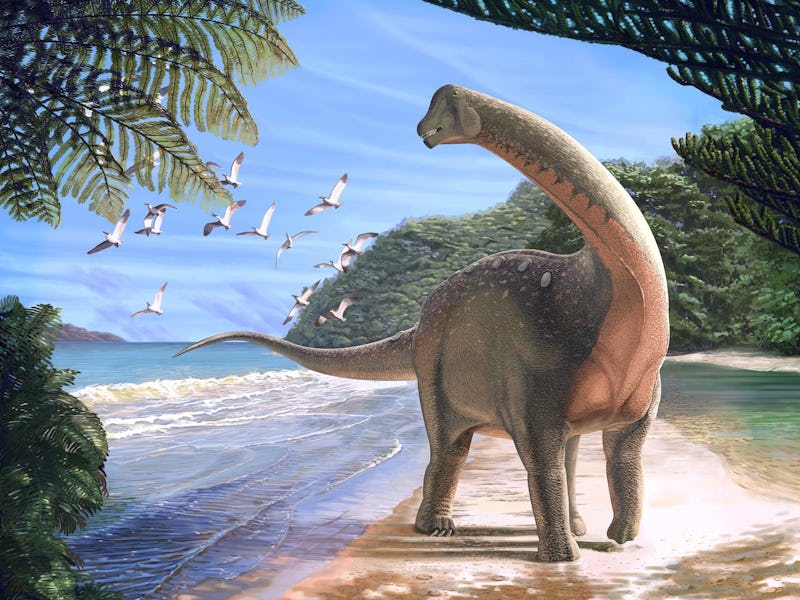Newly Discovered Egyptian Dinosaur Is "Holy Grail" of Fossils
"When I first saw pics of the fossils, my jaw hit the floor."

In Egypt, buried within a stretch of the Sahara Desert, paleontologists have unearthed a new species of dinosaur that could finally solve the mystery of Africa’s ancient giant reptiles. This dinosaur, named the Mansourasaurus shahinae, is part of the long-necked, plant-eating group of sauropods called titanosaurs. Estimated to weigh as much as a present-day African bull elephant, scientists are calling the new skeleton the corner piece in the African dinosaur puzzle.
“When I first saw pics of the fossils, my jaw hit the floor,” study co-author and Carnegie Museum of Natural History paleontologist Matt Lamanna, Ph.D., said in a statement released Monday.
“This was a Holy Grail — a well-preserved dinosaur from the end of the Age of Dinosaurs in Africa — that we paleontologists had been searching for, for a long, long time.”
The lower jaw bone of the Mansourasaurus shahinae.
The discovery of the Mansourasaurus is described in a study published Monday in Nature Ecology and Evolution. Its extraction by a team of international researchers was led by the Vertebrate Paleontology initiative at Mansoura University, an Egyptian public university that served as part of the inspiration for the new dinosaur’s name. Described by study co-author Eric Gorscak, Ph.D., as a “critical discovery for Egyptian and African paleontology,” the dinosaur remains are mostly intact, making it the most complete dinosaur specimen discovered from the Cretaceous period in Africa.
These bones, estimated to be around 80 million years old, were discovered in a rock formation in the Dakhla Oasis. Fossils found in Africa from the Late Cretaceous period are extremely rare, creating a puzzling gap in the fossil record. It’s been more difficult to find dinosaur fossils in Africa because most of the land where fossils may be buried is covered in lush vegetation. The exposed nature of other fossil-rich places, like Patagonia and the Gobi Desert, has been a boon for paleontologists working there.
This mystery has been all too tantalizing for scientists because Africa during the Cretaceous period was a rough and wild ride. That’s when the continents began pulling apart from massive continents of Gondwanaland and Laurasia, shifting into the configuration we have today. It’s unclear how connected Africa and Europe were at the time and whether the separation of the continents caused African animals to evolve uniquely.
The Mansourasaurus is a titanosaurian sauropod dinosaur.
Analysis of the Mansourasaurus bones reveals that, at least during the Cretaceous period, there had to be some way dinosaurs could move between Africa and Europe. This titanosaur is more closely related to dinosaurs from Europe and Asia than it is to fossils found in South Africa or even further south in Africa. That’s quite different from one of the last dinosaurs to be found in Africa: a 66 million-year-old Chenanisaurus barbaricus that caused scientists to think that distinct fauna evolved in Africa.
The relationship between Manosourasaurus and better-characterized European and Asian species is exciting for scientists because it sheds light on how dinosaurs moved across continents. Knowing this, in turn, can shine a light on the evolutionary history of the animals that live there today.
“Africa remains a giant question mark in terms of land-dwelling animals at the end of the Age of Dinosaurs,” said Gorscak. “[This discovery] is like finding an edge piece that you use to figure out what the picture is, that you can build from. Maybe even a corner piece.”